|
|
 |
| Interested in an aviation-related book? Find it at... |
|
|
|
|
SW Aviator Magazine
|
3909 Central NE
Albuquerque, NM 87108
Phone: 505.256.7031
Fax: 505.256.3172 |
| publisher@swaviator.com |
|
PIMA Air and Space Museum
Preserving the Best of the Boneyard |
| story by Mark Swint, photos by Mark Swint and Mike Scott |
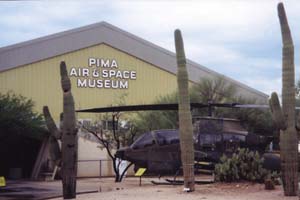 Arizona is an amazing place! As winter closes in around the country and weekend warriors everywhere sit grounded by snow and low visibility, Arizona beckons, offering the siren’s call of spring-like weather and wonderful flying conditions. Pilots can usually count on VMC, and a variety of interesting places to visit. If you are planning a trip to this part of the great Southwest, consider adding the Pima Air Museum as a must-see item on your itinerary. Arizona is an amazing place! As winter closes in around the country and weekend warriors everywhere sit grounded by snow and low visibility, Arizona beckons, offering the siren’s call of spring-like weather and wonderful flying conditions. Pilots can usually count on VMC, and a variety of interesting places to visit. If you are planning a trip to this part of the great Southwest, consider adding the Pima Air Museum as a must-see item on your itinerary.
Located in Tucson, the Pima Air & Space Museum is the largest private air museum in the U.S. and the third largest overall. It trails only the Smithsonian and the Dayton Air Force museums in total numbers of aircraft. Created in May of 1976 by the Arizona Aerospace Foundation, the museum started with 75 aircraft and has steadily grown to its current collection of over 250 airplanes sitting on 80 acres. The total grounds now cover 150 acres, with the remaining land providing space for restoration facilities and other service buildings.
The Pima Air Museum is a natural outgrowth of Arizona’s unique role as the preeminent aircraft repository for surplus and inactive aircraft. Just across the street from the Museum lies Davis-Monthan Air Force Base, which is the official aircraft storage facility for the Armed Forces. Known locally as AMARC (Aerospace Maintenance and Regeneration Center), and universally as “the boneyard,” Davis-Monthan is the permanent or temporary resting place for over 5,000 surplus or inactive aircraft spread over 2600 acres. Many of these aircraft will fly again, some in the colors of other countries, while others serve as parts bins for aircraft still active in the inventory. Sadly, others, such as the venerable B-52, await an ignominious end underneath the blade of the guillotine, which cuts them up and leaves them in full view of the Russian satellites flying overhead to verify the terms of strategic arms reduction treaties.
Davis-Monthan isn’t the only storage facility for old planes. Many, if not most, of the once active military training bases scattered throughout Arizona host at least a few relics from the past as well as more current airliners retired from various fleets around the world. A booming trade in aircraft preservation and restoration thrives in Arizona. Many once proud airliners leave the warm dry climes of the Southwest for duty in other parts of the world as cargo liners or smaller scale passenger carriers in third world countries.
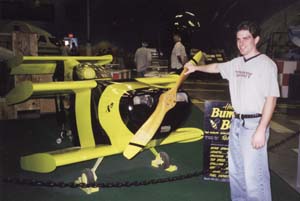 The founders of the Pima Air & Space Museum decided to capitalize on this uniquely Arizona role, and have managed to amass an impressive collection of aircraft, which well represent the spectrum of U.S. aviation history — both military and civilian. For a reasonable museum admission fee, you enter a lovely new building where you are immediately confronted with the earliest history of powered flight. As you walk through the entrance, a replica of the Wright Flyer is the first plane to greet you. This same building/ hangar houses fine examples of old radial engines as well as some of the more historic airplanes of the First World War. Included in this building is a variety of civilian aircraft from the reliable Taylorcraft to an early Lear Jet Model 23. There are also some notable experimental homebuilt aircraft on display, including the Pitts S-1 and a plane billed as the smallest manned airplane in the world. The tiny Bumble Bee sports a wingspan of only 6 feet and though it does not say whether anyone other than the builder - Robert Starr - ever flew it, it did, in fact fly. I think it is amazing that it made it to display in the museum in one piece. The founders of the Pima Air & Space Museum decided to capitalize on this uniquely Arizona role, and have managed to amass an impressive collection of aircraft, which well represent the spectrum of U.S. aviation history — both military and civilian. For a reasonable museum admission fee, you enter a lovely new building where you are immediately confronted with the earliest history of powered flight. As you walk through the entrance, a replica of the Wright Flyer is the first plane to greet you. This same building/ hangar houses fine examples of old radial engines as well as some of the more historic airplanes of the First World War. Included in this building is a variety of civilian aircraft from the reliable Taylorcraft to an early Lear Jet Model 23. There are also some notable experimental homebuilt aircraft on display, including the Pitts S-1 and a plane billed as the smallest manned airplane in the world. The tiny Bumble Bee sports a wingspan of only 6 feet and though it does not say whether anyone other than the builder - Robert Starr - ever flew it, it did, in fact fly. I think it is amazing that it made it to display in the museum in one piece.
Beyond the main building a path leads to the main area of the mostly outdoor museum. For $3.00 per day, you may take one of several shuttle buses on a guided tour of the grounds. The tour takes about 50 minutes, and you are free to get off and on as often as you like. If you prefer to walk, you can forego the tram and stroll among the planes at your leisure. My son David and I had a fascinating time walking in, around and under some of the more interesting planes of the collection.
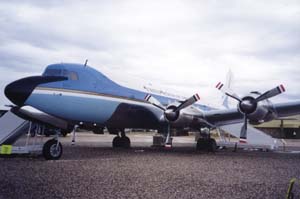 The first display on the tour is a collection of planes from the presidential fleet. This included the DC-6 first used by President Harry S. Truman. This plane has been set up for on-board tours, and has a nice presentation of presidential plane facts and history. The collection also includes President Eisenhower’s Lockheed Constellation, “Columbine.” There is a Lockheed Jetstar that served in the executive fleet and, of course, what collection would be complete without a Boeing 707/720. The latter, number 26001, was not the primary Air Force One used by the president but was, on occasion, called upon to fill in as a back up. It did accompany A.F.1, usually serving as a press plane or for other dignitaries (any plane on which the president travels is called Air Force One, Marine One or Navy One as appropriate). Incidentally, it was Jackie Kennedy who influenced the beautiful and regal blue paint scheme of all subsequent Air Force One and Executive fleet aircraft that we see today. During the Kennedy administration the words “The United States of America” were first emblazoned across the top of the plane rather than “U.S. Air Force.” The first display on the tour is a collection of planes from the presidential fleet. This included the DC-6 first used by President Harry S. Truman. This plane has been set up for on-board tours, and has a nice presentation of presidential plane facts and history. The collection also includes President Eisenhower’s Lockheed Constellation, “Columbine.” There is a Lockheed Jetstar that served in the executive fleet and, of course, what collection would be complete without a Boeing 707/720. The latter, number 26001, was not the primary Air Force One used by the president but was, on occasion, called upon to fill in as a back up. It did accompany A.F.1, usually serving as a press plane or for other dignitaries (any plane on which the president travels is called Air Force One, Marine One or Navy One as appropriate). Incidentally, it was Jackie Kennedy who influenced the beautiful and regal blue paint scheme of all subsequent Air Force One and Executive fleet aircraft that we see today. During the Kennedy administration the words “The United States of America” were first emblazoned across the top of the plane rather than “U.S. Air Force.”
Much of the Pima Air Museum’s outdoor display is organized into groupings of aircraft with similar missions. For example, right past the executive fleet is a nice display of the “Century Series airplanes, including the F-100, F-101, F-102, F-104, F-105, F-106 and F-107. Other groups of aircraft include heavy bombers, (including three B-52 variations), attack aircraft, cargo, training, reconnaissance, fighters, and electronic countermeasure aircraft. The yard also has a line of Mig fighters, as well as various utility and multi-role aircraft. Some unique aircraft fall into a category all their own, such as the monstrously huge Boeing – Aerospacelines B-337SG “Super Guppy.” As a kid, I actually saw this aircraft and its predecessors fly in regular operations, and it was fun to see it again.
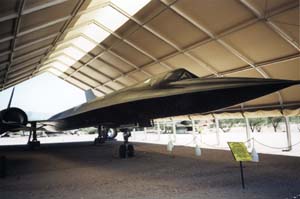 One truly unique display, which always draws big crowds, is a large tent covering an SR-71. You can walk right up to and almost touch the ultra-sophisticated “Blackbird.” This is probably the best chance you’ll get to an up close and personal look at the best technology to come out of Kelly Johnson’s “Skunk Works” back in the 60’s. One truly unique display, which always draws big crowds, is a large tent covering an SR-71. You can walk right up to and almost touch the ultra-sophisticated “Blackbird.” This is probably the best chance you’ll get to an up close and personal look at the best technology to come out of Kelly Johnson’s “Skunk Works” back in the 60’s.
The Pima Air & Space Museum has erected, in addition to the main building, six other buildings and hangars which house displays. Hangar #2 is home to the Arizona Hall of Fame and the Stitt Auditorium/Theater. Hangar #3 is dedicated to WWII, and houses such beauties as a B-24, B-25, C-47 and A-26 along with a fighter exhibit. The one aircraft missing though is the P-51. These planes are so coveted that all flying models fetch prices nearing one million dollars. All non-flying copies not already in museums are squirreled away in shops, undergoing restoration to return to flying status – where I think they should be anyway.
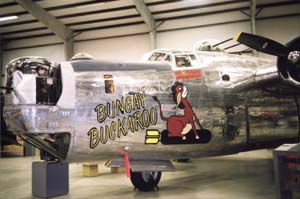 Hangar #4 contains additional WWII aircraft, such as the B-29 (another sits outside), P-36 “King Cobra,” TBM Avenger, and the F4U Corsair. A fifth building houses the 390th Memorial Museum, and has a beautiful display of a B-17G “Flying Fortress.” Hangar #4 contains additional WWII aircraft, such as the B-29 (another sits outside), P-36 “King Cobra,” TBM Avenger, and the F4U Corsair. A fifth building houses the 390th Memorial Museum, and has a beautiful display of a B-17G “Flying Fortress.”
The Pima Air & Space Museum hosts two other interesting tours. One is a tour of the AMARC at Davis-Monthan AFB. This tour lasts approximately one hour and is strictly guided. Unfortunately, for all of us airplane lovers, visitors to AMARC are not allowed to wander around the base unescorted. However, the tour is quite complete, and patrons get to see not only lots and lots (I mean and lots!) of airplanes, but also the facilities where planes are prepared for storage or regeneration. The tour leaves from the entrance to the Museum. I found it fascinating and well worth the $6.00 fee.
The other tour offered by the museum is a visit to a Titan missile silo. The Titan Missile Museum National Historic Landmark is located at Titan II ICBM Site 571-1 south of Tucson. This is the only publicly accessible missile complex in the world. Visitors to the site will get a unique glimpse into the secret world of strategic missiles, and the efforts that were made during the cold war to protect the U.S. from nuclear attack. This site is open to the public every day except Thanksgiving and Christmas throughout the cooler months. Summer hours are Wednesday through Sunday 9:00am – 5:00pm.
The Pima Air Museum also plays host to wonderful organization called the Challenger Learning Center. The Challenger Foundation was begun in memory of the Space Shuttle Challenger crew and mission. It is dedicated to facilitating and enhancing children’s understanding and appreciation of science and aeronautics. To that end, the foundation has established 42 learning centers throughout the country, with several more slated for opening soon, including one in England and two in Canada. The learning centers offer several programs for schools and private groups, and even have a program for corporations. The activities run from a few hours to an overnight camp.
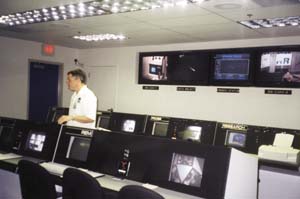 The school programs involve bringing students to the Learning Center for a one-day “Shuttle mission” experience. They are first introduced into a briefing room where aspects of the mission are discussed. The students are then divided into two groups, one serving as mission control while the other acts as the flight team. The facility has a very realistic Mission Control room and a Shuttle bay “lab” that is entered through an airlock! A launch countdown is initiated and a simulated launch – complete with vibrating floor and real launch sounds – takes place. The mission control crew have to work together to accomplish all the tasks assigned to them, while the shuttle crew also must work as a team to build, test, and prepare to launch a probe designed to penetrate a comet’s tail. The school programs involve bringing students to the Learning Center for a one-day “Shuttle mission” experience. They are first introduced into a briefing room where aspects of the mission are discussed. The students are then divided into two groups, one serving as mission control while the other acts as the flight team. The facility has a very realistic Mission Control room and a Shuttle bay “lab” that is entered through an airlock! A launch countdown is initiated and a simulated launch – complete with vibrating floor and real launch sounds – takes place. The mission control crew have to work together to accomplish all the tasks assigned to them, while the shuttle crew also must work as a team to build, test, and prepare to launch a probe designed to penetrate a comet’s tail.
Throughout the mission activities, both crews at the learning center must deal with problems and even emergencies as they go through their assignments. Without proper teamwork the mission will fail, so kids learn the value of cooperation. Before the day is over the crews have changed places so that each student gets a chance to be part of both mission control and a shuttle crew.
Whatever your interest in aviation history, the Pima Air & Space Museum has something for you. Visit their web site at www.Pimaair.org for more information, or call (520) 574-0462. To arrange for tours of AMARC and the Titan Missile Museum dial ext. 106. Whatever your need, the volunteers there will be happy and able to help.
|
TUCSON INTERNATIONAL
The closest airport to the Pima Air Museum is Tucson International (TUS). This moderately busy commercial airport is relatively simple for GA use. Tucson International shares Class C airspace with Davis-Monthan AFB, 4.5 miles to the northeast. Tucson Approach will provide vector to the airport, contact them at least 30 miles out. Monitor ATIS 123.8 prior to contacting approach for specific instructions.
If arriving from the west, avoid directly overflying the historic Spanish mission of San Xavier, five miles west of the airport, as the vibration from aircraft noise hastens deterioration of this beautiful and fragile structure. Arrivals from the east may be treated to vectors over the Davis-Monthan “Boneyard”– ensure your passengers have a camera ready.
Fuel is available 24 hours, seven days a week from the Tucson Airport Authority (520-573-8190, UNICOM 122.95), located at the base of the control tower. Transient parking is directly northwest of the tower, tie downs run $5.50 a night for singles, $11 for medium twins. The first nights fees are waived with a fuel purchase. There are also several FBO’s in this area.
Rental cars and taxis are available at the Executive Terminal. Most major brands of rental cars are represented at TUS, with a Budget desk located in the Executive Terminal and the others only a phone call away at the Airline Terminal. A taxi to the Pima Air Museum will run $12 to $15 each way, call the Airport Authority 15 minutes out on UNICOM to order a cab. Several good hotels in the vicinity of the airport offer courtesy transportation. Tucson is a beautiful city with many other attractions and stunning desert scenery, plan to stay awhile.
|
| Click here to return to the beginning of this article. |
The material in this publication is for advisory information only and should not be relied upon for navigation, maintenance or flight techniques. SW Regional Publishing, Inc. and the staff neither assume any responsibilty for the accuracy of this publication's content nor any liability arising out of it. Fly safe.
|
|
|
|

